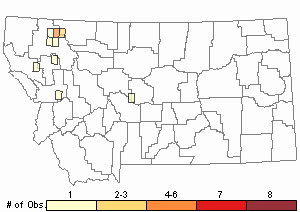View in other NatureServe Network Field Guides
NatureServe
Montana
Utah
Wyoming
Idaho
Wisconsin
British Columbia
South Carolina
Yukon
California
New York
Twisted Dry Rock Moss - Grimmia torquata
Other Names:
Twisted Black Rock Moss
General Description
Plant: Soft, easily disintegrating cushions. Yellow-green to brown, sometimes light green. Inside black to red-brown. Stems 1.0-4.0 cm tall. X-S of stem with a small central strand.
Leaf: Contorted when dry. When moist, the leaf and stem make a 26-45 degree angle (patent). Lanceolate, 1.5-2.0 x 0.3-0.5 mm, and keeled. Awn very short and smooth, sometimes absent. Margins near base of leaf slightly recurved; otherwise plane. Costa reaches apex, but is weak at base, and projects on the abaxial side.
Leaf Cells: Basal laminal cells near costa linear, very sinuose, and thick-walled. Basal laminal cells near margin long-rectangular, thin-walled, and hyaline. Median laminal cells rectangular, very sinuose, and thick-walled. X-S: distal laminal cells are 1-layered; cells do not bulge.
Diagnostic Characteristics
Distinctive characteristics include the yellow-brown cushions that have contorted leaves (dry), and brown gemmae. In shaded environments the plants are more green and less brown. It often grows in small numbers.
Range Comments
Greenland; Canada: AB, BC, NL, NT, ON, QC, YT; USA: AK, AZ, CA, CO, ID, MT, NV, OR, WA, WY; Mexico; Eurasia; n Africa; Pacific Islands (Hawaii) (FNA 2007). In Montana, known from Cascade, Flathead, Glacier, Lincoln, Missoula, and Sanders Counties (Elliott 2016).
Observations in Montana Natural Heritage Program Database
Number of Observations: 17
(Click on the following maps and charts to see full sized version)
Map Help and Descriptions
Relative Density

Recency



 (Observations spanning multiple months or years are excluded from time charts)
(Observations spanning multiple months or years are excluded from time charts)
Habitat
Damp, usually vertical faces of acidic rock (granite, gneiss, quartzite, and schist). Moderate to high elevations (650-13,100 feet). This is a montane-alpine species which prefers shaded habitats. It grows in half-sphere cushions on steep, damp rock faces.
Reproductive Characteristics
Dioicous. Seta is 3-5 mm tall, curved (moist) or straight (dry), and symmetrically attached to the base of capsule. Capsules sporadically found, exserted, brown, ovoid, and smooth.
Gemmae on the abaxial side of upper leaves, brown, and multicellular.
Stewardship Responsibility
References
- Literature Cited AboveLegend:
 View Online Publication
View Online Publication Elliott, J.C. and A.K. Pipp. 2018. A Checklist of Montana Mosses (1880-2018). Updated 3 January, 2020. Montana Natural Heritage Program, Helena, Montana. 73 pp.
Elliott, J.C. and A.K. Pipp. 2018. A Checklist of Montana Mosses (1880-2018). Updated 3 January, 2020. Montana Natural Heritage Program, Helena, Montana. 73 pp. Flora of North America Editorial Committee, eds. 2007. Flora of North America North of Mexico. Volume 27. Bryophytes: Mosses, Part 1. Oxford University Press, Inc., NY. xxi + 713 pp.
Flora of North America Editorial Committee, eds. 2007. Flora of North America North of Mexico. Volume 27. Bryophytes: Mosses, Part 1. Oxford University Press, Inc., NY. xxi + 713 pp.
- Additional ReferencesLegend:
 View Online Publication
View Online Publication
Do you know of a citation we're missing? Elliot, J. C. 1993. Second checklist of Montana mosses. Unpublished report. U.S. Forest Service, Region 1. Missoula, MT. 45 pp.
Elliot, J. C. 1993. Second checklist of Montana mosses. Unpublished report. U.S. Forest Service, Region 1. Missoula, MT. 45 pp. Lawton, E. 1971. Keys for the Identification of the Mosses on the Pacific Northwest. Reprinted from 'Moss Flora of the Pacific Northwest'. Published as Supplement No. 2 of the Journal of the Hattori Botanical Laboratory. Nichinan, Miyazaki, Japan. 66 pp.
Lawton, E. 1971. Keys for the Identification of the Mosses on the Pacific Northwest. Reprinted from 'Moss Flora of the Pacific Northwest'. Published as Supplement No. 2 of the Journal of the Hattori Botanical Laboratory. Nichinan, Miyazaki, Japan. 66 pp. Lawton, E. 1971. Moss Flora of the Pacific Northwest. Hattori Botanical Laboratory. Japan: Yamabuki-cho, Shinjuku-ku, Tokyo. 362 pages plus appendices.
Lawton, E. 1971. Moss Flora of the Pacific Northwest. Hattori Botanical Laboratory. Japan: Yamabuki-cho, Shinjuku-ku, Tokyo. 362 pages plus appendices.
- Web Search Engines for Articles on "Twisted Dry Rock Moss"





